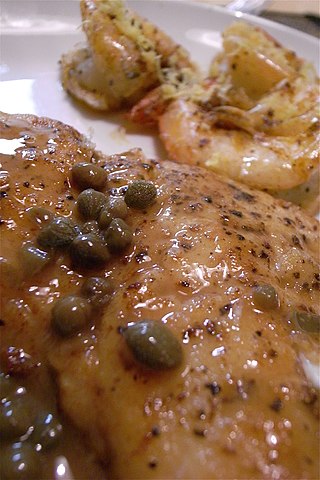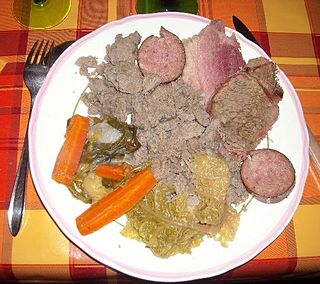
Pasta is a type of food typically made from an unleavened dough of wheat flour mixed with water or eggs, and formed into sheets or other shapes, then cooked by boiling or baking. Rice flour, or legumes such as beans or lentils, are sometimes used in place of wheat flour to yield a different taste and texture, or as a gluten-free alternative. Pasta is a staple food of Italian cuisine.

Lutefisk is dried whitefish. Usually cod is used, but ling and burbot are also used. It is made from aged stockfish, or dried and salted cod, cured in lye. The fish adopts a gelatinous texture after being rehydrated for days prior to eating.

Pastry is baked food made with a dough of flour, water and shortening that may be savoury or sweetened. Sweetened pastries are often described as bakers' confectionery. The word "pastries" suggests many kinds of baked products made from ingredients such as flour, sugar, milk, butter, shortening, baking powder, and eggs. Small tarts and other sweet baked products are called pastries as a synecdoche. Common pastry dishes include pies, tarts, quiches, croissants, and pasties.

Porridge is a food made by heating or boiling ground, crushed or chopped starchy plants, typically grain, in milk or water. It is often cooked or served with added flavourings such as sugar, honey, fruit or syrup to make a sweet cereal, or it can be mixed with spices, meat or vegetables to make a savoury dish. It is usually served hot in a bowl, depending on its consistency. Oat porridge, or oatmeal, is one of the most common types of porridge. Gruel is a thinner version of porridge and congee is a savoury variation of porridge of Asian origin.

Louisiana Creole cuisine is a style of cooking originating in Louisiana, United States, which blends West African, French, Spanish, and Native American influences, as well as influences from the general cuisine of the Southern United States.

Roux is a mixture of flour and fat cooked together and used to thicken sauces. Roux is typically made from equal parts of flour and fat by weight. The flour is added to the melted fat or oil on the stove top, blended until smooth, and cooked to the desired level of brownness. A roux can be white, blond (darker) or brown. Butter, bacon drippings or lard are commonly used fats. Roux is used as a thickening agent for gravy, sauces, soups and stews. It provides the base for a dish, and other ingredients are added after the roux is complete.

Macaroni and cheese is a dish of cooked macaroni pasta and a cheese sauce, most commonly cheddar sauce.

Fettuccine Alfredo or fettuccine al burro is an Italian pasta dish of fresh fettuccine tossed with butter and parmesan. As the cheese melts, it emulsifies the liquids to form a smooth and rich cheese sauce coating the pasta. The dish is named after Alfredo Di Lelio, who featured the dish at his restaurant in Rome in the early to mid-20th century; the "ceremony" of preparing it tableside was an integral part of the dish.

Hollandaise sauce, meaning Dutch sauce in French, is a mixture of egg yolk, melted butter, and lemon juice. It is usually seasoned with salt, and either white pepper or cayenne pepper.

Eritrean cuisine is based on Eritrea's native culinary traditions, but also arises from social interchanges with other regions. The local cuisine, despite featuring influences of both the Ottoman and Italian cuisines, shares similarities with the cuisine of neighboring Ethiopia and the cuisines from other African countries in the region.

Arab cuisine is the cuisine of the Arab world, defined as the various regional cuisines of the Arab people, spanning from the Maghreb to the Fertile Crescent and the Arabian Peninsula. These cuisines are centuries old and reflect the culture of trading in ingredients, spices, herbs, and commodities. The regions have many similarities, but also unique traditions. They have also been influenced by climate, cultivation, and mutual commerce.
Norwegian cuisine in its traditional form is based largely on the raw materials readily available in Norway and its mountains, wilderness, and coast. It differs in many respects from continental cuisine through the stronger focus on game and fish. Many of the traditional dishes are the result of using conserved materials, necessary because of the long winters.

Meunière is both a French sauce and a method of preparation, primarily for fish, consisting of brown butter, chopped parsley, and lemon. The name suggests a simple rustic nature, i.e. that to cook something à la meunière was originally to cook it by first dredging it in flour.

Dominican cuisine is made up of Spanish, indigenous Taíno, Middle Eastern and African influences.

Fricassee or fricassée is a stew made with pieces of meat that have been browned in butter then served in a sauce flavored with the cooking stock. Fricassee is usually made with chicken, veal or rabbit, with variations limited only by what ingredients the cook has at hand.

Clarified butter is milk fat rendered from butter to separate the milk solids and water from the butterfat. Typically, it is produced by melting butter and allowing the components to separate by density. The water evaporates, some solids float to the surface and are skimmed off, and the remainder of the milk solids (casein) sink to the bottom and are left behind when the butterfat is poured off or separated with a separatory funnel or a gravy fat separator. This butterfat is the clarified butter.

Neapolitan cuisine has ancient historical roots that date back to the Greco-Roman period, which was enriched over the centuries by the influence of the different cultures that controlled Naples and its kingdoms, such as that of Aragon and France.

Sponge cake is a light cake made with egg whites, flour and sugar, sometimes leavened with baking powder. Some sponge cakes do not contain egg yolks, like angel food cake, but most of them do. Sponge cakes, leavened with beaten eggs, originated during the Renaissance, possibly in Spain. The sponge cake is thought to be one of the first of the non-yeasted cakes, and the earliest attested sponge cake recipe in English is found in a book by the English poet Gervase Markham, The English Huswife, Containing the Inward and Outward Virtues Which Ought to Be in a Complete Woman (1615). Still, the cake was much more like a cracker: thin and crispy. Sponge cakes became the cake recognized today when bakers started using beaten eggs as a rising agent in the mid-18th century. The Victorian creation of baking powder by English food manufacturer Alfred Bird in 1843 allowed the addition of butter to the traditional sponge recipe, resulting in the creation of the Victoria sponge. Cakes are available in many flavours and have many recipes as well. Sponge cakes have become snack cakes via the Twinkie.

Kig ha farz is a cooked dish consisting of various meats simmered in a broth with a buckwheat flour based pudding. It is eaten traditionally in Brittany, more specifically around Léon in the region situated west from Morlaix to Brest. This dish, which is quite similar to a pot-au-feu, was once considered a dish for the poor and peasantry. The name in Breton literally means "meat and stuffing".

Venetian cuisine, from the city of Venice, Italy or more widely from the region of Veneto, has a centuries-long history and differs significantly from other cuisines of northern Italy, and of neighbouring Austria and of Slavic countries, despite sharing some commonalities.


















